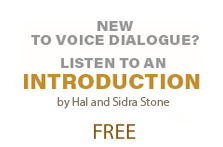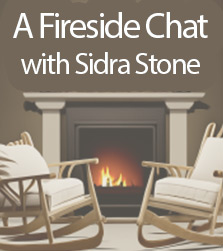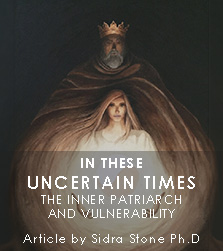by Hal Stone, Ph.D. & Sidra Stone, Ph.D.
From Gary Zukav’s Website When Hal & Sidra Stone were his Soul Guests 7/15—8/15/2001
We each knew all the answers to most of life’s questions when we met over thirty years ago. They were often opposite answers, but we were in love and this didn’t seem to be a problem. Instead, we were **fascinated by our differences** (understanding rel. CD), and, as two seasoned, mature clinical psychologists, we were curious to explore them.
As a matter of fact, we were so in love that we wanted to know everything that we could about one another. So it was that we talked about our lives, our feelings, our dreams and our imaginings. We meditated and prayed together. It was a truly profound interaction, but there were no real surprises. We each still knew what we knew, we still did not know what we did not know, and we did not move very far beyond those boundaries.
And then one day we discovered our “selves.” We had been talking about vulnerability and Hal suggested that I (Sidra) move over to another part of the room and become the vulnerable child instead of talking about it. I trusted Hal and so I left the couch I’d been sitting on, sat on the floor next to the coffee table, put my head down on it and suddenly everything changed. I became absolutely quiet and experienced the world around me differently. Sounds, colors and feelings were more intense than before.
The sophisticated, rational, articulate woman with all the answers was gone and in her place was a very young child. I was extremely quiet and very sensitive to everything in my surroundings. I responded to energies rather than thoughts. I felt things I had not felt in decades, and knew things that were not known by my everyday mind. I knew, without question, the realities of my soul. After about an hour, Hal asked me to move to my original seat on the couch and I returned to my previous way of being in the world... but my little girl was still with me and I would never lose her completely again.
This experience was a surprise to both of us! I (Hal) knew that something extremely important had just happened, that we had moved into another dimension of consciousness. I had played with talking to parts, but they were never real to me. Now they were real people. This was indeed a little girl—it wasn’t a concept or a complex; she was a real person with rules of behavior, feelings, perceptions, reactions, and a history of her own.
This was the beginning of Voice Dialogue, or the dialogue with the family of selves that lives within each of us. It was conceived out of a genuine curiosity about another human being and was born in love. Embracing Our Selves: The Voice Dialogue Manual gives the details on how Voice Dialogue works.
We were very excited about our discovery. We saw that our psyches were not unitary but, instead, were made up of many selves and we set out on what has proven to be an unending journey. We went on to explore a vast multitude of selves. We spoke with pushers and critics and pleasers and perfectionists. And we spoke with beach bums, slackers, and manipulators. We spoke with feeling selves and unfeeling selves, with vulnerable, playful and magical children. We spoke with heroes and villains, matriarchs and patriarchs. We spoke with visionaries and cynics. The range of selves is amazing; it seems to be limitless.
We spoke to our “primary selves” which were very well developed. They ran our lives or, as we liked to put it, they drove our psychological cars. They were the ones that made up our personalities; the selves that “knew all the answers” when we first met. Then we went on to learn about our “disowned selves.” For each primary self there were opposite disowned selves, that were buried or repressed so that the primaries could keep control of our lives.
The primary selves were familiar and we were comfortable with them. It was easy to get them to talk and to tell us how cleverly and successfully they ran our lives. The disowned selves were unfamiliar and threatening to our primary selves. Each primary self felt that the disowned self on the other side was a potential destroyer of our wellbeing. For instance: “What happens if you really let go and learned to ‘be’ instead of to ‘do?’ You might never want to work again!” would be the Pusher’s concern.
When we talked with these disowned selves we felt as though we were living in a house with endless doors waiting to be opened with new rooms to explore. These selves carried new ways of looking at the world, new information, and creative solutions to old problems.
Then there were the areas in which one of us had a primary self that was the disowned self of the other. For example, Sidra had a strong “What will people think?” self while Hal’s was the opposite: “I do what is right for me.” Hal had a deeply spiritual self while Sidra’s was more pragmatic. Hal was the Introvert while Sidra was the Extrovert. Sidra had a Financial Conservative while Hal had a Financial Liberal. Hal was a fearless explorer of the world within and Sidra was a fearless explorer of the world outside. And so it went.
These opposite primary selves presented a challenge. They added a new dimension to our relationship: judgment. Each of these disowned selves was one of God’s little heat-seeking missiles that impacted us where it hurt the most. In our relationship! When we examined this phenomenon, we discovered that our judgments were not bad, they were simply signs that we had something to learn. Each time one of us judged the other, we were facing a disowned self.
In the past we had tried hard to avoid judging others. We felt that we were too mature and spiritually evolved for this. Now we learned to use our judgments. Each time we felt a judgment, it gave us the picture of a disowned self that needed integration. So we looked at the judgment, clarified it, and found the disowned self. For instance, Sidra might have judged Hal to be too free with money. We would look at this, determine that her primary self was a financial conservative and then work with the opposites of big spender and financial conservative in her.
We went on to discover how these selves interact in relationships. Relationships, we discovered, are the interactions of not just two people, but two groups of selves. These interactions follow simple predictable patterns. To move beyond the automatic, unconscious relating of these selves, we entered a new area of exploration and understanding.
As a way of learning about ourselves and others, Voice Dialogue is completely accepting and non-judgmental. It simply looks at what is. Some have called it a Western meditation because, as each self is explored, an awareness of that self develops. This awareness is separate from the self and acts as a witness. It carries with it a memory and an ability to recognize this self as it operates in our lives.
But that is not all that happens. Yes, it is important to have a witness that is aware of a self, but a witness just witnesses. We live in the world, however, not in an ashram. Who lives life? We saw that after we had separated from one of our primary selves, there was a qualitative change in the way we lived our lives. In the deepest spiritual sense, we were separating from who we thought we were and allowing a new process to emerge. We named it an Aware Ego.
Voice Dialogue is about separating from the many selves that make up the human psyche and creating this Aware Ego. We do not discard anything. We embrace the selves that are already ours and we add to them those we have disowned. It is as though we were living in ancient Greece and worshipping at the shrines of all the gods and goddesses. We can have our favorites, but we take care not to neglect any of the others.
And as we embrace all that we are, we naturally become more fully human and more compassionate. We don’t have to learn compassion, it just appears. After all, everything out there is within each of us.
We feel that the Aware Ego is an evolutionary step forward. This Aware Ego blends awareness with an experience of selves. It moves beyond duality by carrying the tension of opposites and, because it does so, it allows us real choices in life. It enables us to follow—safely— our unique paths.
As someone wrote to us recently: “There
is something built into the method you have
seeded which reminds me of a desert proverb:
‘Listen to the path... it is wiser than he who
travels it’.”
© 2001






